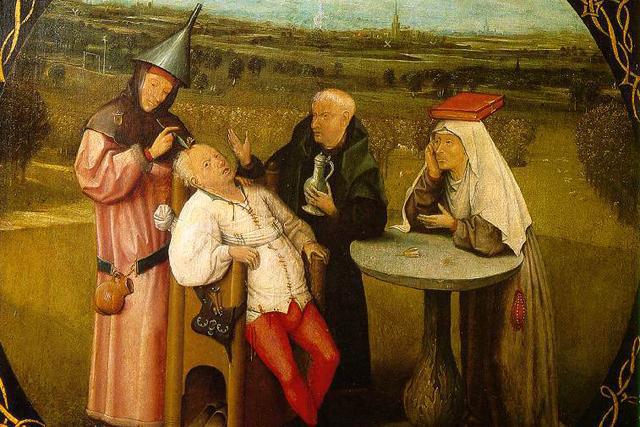The early history of surgery isn’t a pleasant one; it was a last-ditch measure when no alternatives were available, and, in truth, was as likely to end a life as to save one. Nonetheless, early surgeons performed a range of different surgeries long before modern medicine. Sometimes, their patients even survived.
Surgical techniques were at their best in classical Greece, Rome and India, as well as during the Middle Ages in the Middle East and their worst in Europe throughout the Middle Ages and early modern period.
These surgeries ranged from trepanation, or drilling into the skull, to the removal of bladder stones and repair of anal fistulas. Surgeons did not, before the modern era, typically attempt to perform any sorts of extensive internal surgeries.

Trepanation
Trepanation is the process of creating an opening in the skull, either by drilling or sawing. The procedure typically refers to the removal of a circular piece of bone from the skull. Trepanation, also called trephining or trepanning, has its origins during the Neolithic period. More than 1500 skulls found dating to the Neolithic period show evidence of trepanation, with, in some cases, multiple holes in the skull.
Evidence suggests that the majority of cases of trepanation involved adult males; however, women and children’s skulls have also been found with evidence of holes drilled in the skull. Some cases of trepanation may have occurred after death, rather than before. In those cases, the piece of the skull may have served a magical or spiritual function, perhaps as a protective charm.
In Peru, some skulls suggest that surgeons may have practiced on the dead to improve the likelihood of successful surgeries on the living. Evidence from skulls found in Peru shows that some individuals survived the operation, as the skulls have signs of bone re-growth. The survivors would have retained a significant injury for some time following the operation.
From a modern medical perspective, trepanation has potential benefits. In the case of a head injury, the brain can swell. It is certainly possible that some instances of trepanation were a direct response to an injury and an attempt to save an individual. Creating an opening in the skull can relieve pressure and release accumulated fluid, saving the patient’s life. Some historians have suggested that trepanation was a form of psychosurgery, designed to manage behavioral or neurological conditions, like epilepsy.
While medical explanations may account for some cases of trepanation, it seems likely that others were spiritual in nature. Perhaps early people believed that surviving trepanation would provide special powers or abilities, or had seen individuals become unconscious and regain consciousness, and viewed this as a sort of magic.

